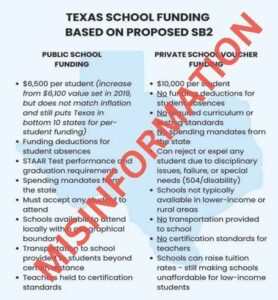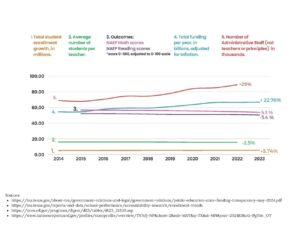As some may know, the “School Choice Bill”, Senate Bill 2, passed out of the Senate this past Wednesday, and will now be moving over to the Texas House. I was proud to vote for SB 2, as it will have a significant impact on the opportunity for and outcomes of education in this great state. This is a much-needed step towards more parent empowerment and involvement when it comes to their child’s education.
However, there is a lot of misunderstanding about the bill; misunderstanding has sparked a lot of opposition and disagreement with the policy. Unfortunately, most of this misconception comes from false and misleading charts and documents that have been carefully crafted to incite emotional opposition to children and their parents wanting the best education environment. These charts have been broadly perpetuated online and in the media.
My office has received a great volume of calls over the past weeks, with constituents and non-constituents alike voicing their opposition based on these misconceptions and urging me to vote no on this legislation.
I care deeply about the voice of SD 2, and representing the people of both my district, and Texas as a whole. It is therefore important to offer corrections to some of these particularly egregious misconceptions:
- Student Funding: Public school funding per student is not just $6k, as many people have been led to believe. Texas has approximately 5,500,000 students in Public Schools with an annual budget of $92.6 B. Thus, public schools will receive approximately $16k per student. For a source, please see this chartfrom TEA.
- Government Strings: Today, if they so chose, without passage of SB 2, the Texas legislature could burden homeschools and private schools with any rule, regulation, restriction or requirement of its choosing. ESA funds will make no difference. Thus, SB 2 changes nothing meaningful with regards to government interference or oversight of homeschool or private schools. It is also crucial to remember that any involvement would be voluntary. Additionally, Sec. 29.368 of the bill (see pg. 21) states that a recipient of this money is not considered recipient of federal financial assistance and may not be considered as a state actor on the basis of receipt. There is also a prohibition against government action that would limit a recipient from determining curriculum, imposing requirements that are contrary to religious or institutional values, determining admissions policies, etc. Any actions taken are required to be as least restrictive as possible (see page 22).
- Certification Standards: Currently, teacher certification is not required for Texas Public Schools. More than half of teachers in public schools today are not certified.
- Other standards: Other “standards” held by public schools such as transportation, acceptance requirements, school location, and spending mandates have no meaningful impact on a quality of education. They are factors that will certainly be weighed by the parents and children making the decision to apply for an ESA.
- Limited Access in Rural Areas: For those concerned about the rural districts, or other areas lacking in private schools where this program could be utilized, it is important to note that nothing would change. This program is entirely voluntary; any participation would be based on a parent’s belief that an ESA would be well utilized.
- Only Benefit to the Wealthy: For those that say this would only help the rich, it is important to note that the average cost of private school in Texas is $10,600. Therefore, this will help many who are unable to afford it at all. For the schools that are above average, taking $10k off the cost does make it more affordable. Source: Education Date Initiative. Additionally, there is a tiered consideration for those who are low-income and/or have disabilities. This is important to note as well. It is not my belief that this bill is a slight to the middle class, rather, it is a hope for an assist to them.
Below is an example of a chart that has been widely circulated, displaying many falsehoods about ESA’s and public school funding.

As you can see, this makes false claims about funding, certification standards, and accessibility. If this was true, the legislation certainly would not have passed. Two other important corrections to these claims are:
- Funding is not deducted for student absence; rather different parts of funding are given based upon both enrollment and average attendance. Source: TEA
- There are spending guidelines and strict supervision from the state for an ESA. Nothing spent by a recipient of an ESA would exceed the amount allotted to them, nor does a recipient ever have access to the money. It goes directly from the comptroller’s office to the educational expense. Source: Page 4-5 of the bill.
Below is a chart which highlights some true, and important information. As you can see, total funding for Texas public schools has increased 22.76% in the past 10 years, adjusted for inflation. Meanwhile, student population has increased only 5.74%, while administrative staff has grown by 29%. This is especially appalling when you consider the student-teacher ratio has only decreased 2.5%. All the while, our average test scores have gone consistently down. None of this is to disparage public schools, rather to demonstrate that increasing funding has not produced better outcomes.

From looking at the data above, specifically the snapshots from 2014, 2018 and 2022, it is clear this is a more complex issue than one that can be solved by continuing to throw money into school districts with no oversight or direction.
It is additionally important to consider the role that local school boards play in this dynamic; they control spending. Each school board has great latitude in how they exercise their responsibility for they how they spend taxpayer dollars. While some expenditures are required and set by law, a school board has complete discretion in setting the priorities for most expenditures. Specifically, the local board, not the state, determines the following:
- Superintendent salary and benefits (150k-550k)
- Teacher pay
- Association dues
- Lobbying
- No bid contracts
- Capital expenditures
- Legal fees
- Anything else not required by law
The bottom line is that if the residents of an Independent School District (ISD) are concerned about teacher pay and other funding needs, they need to look to their local school board and elect members who will prioritize what really matters with the money entrusted to them.
I do plan to work on future legislative efforts to better improve our public schools, as provision of public education is a key constitutional duty of the legislature. However, it is crucial to recognize that funding is not the first, nor the only answer. Just as funding is not the only answer, neither is SB 2. However, it does provide an answer; one that is universally acknowledged to improve outcomes. That is choice. The bill allows students who would otherwise be unable to, to access other forms of education.
In our ever-growing state, needs have diversified greatly. It is not fair to public schools, no matter how well funded or well run they may be, to except them to suit every single one of these needs in the state. It is unfair to tax-paying parents to say that because they cannot afford to, they have no resource to seek alternate forms of education for their children.
There is no responsibility we adults have that is bigger than the education of our children. The truth is that SB 2 is about the education of our children. It is not about the protection of the institution of education. This is crucial point to make, as most of the concerns expressed as opposition to school choice are concerns about the institution, not the actual education of Texas students.
It is clear to me that this is a complex issue. When creating policy, it is imperative to address misconceptions, as understanding the reasoning behind a law is just as important as understanding the law itself. Please do not hesitate to reach out to my office with further questions or concerns about SB 2. I look forward to the other discussions we will continue to have to improve education for every Texas child. I look forward to hearing from you about how you think that will be best accomplished.
